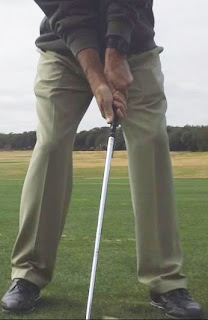In the 47 years I have been playing golf, I have only made two major position changes in my grip. When I was in high school, my grip was very strong on the club. My left hand was turned way too far to the right on the club and of course this caused my right hand to be turned too far under the grip (see picture below). When I looked down at my grip I could see all the knuckles on my left hand and most of my fingers on the right hand. This grip position will lead to hooking the ball, and that is exactly what I did!
 |
| Strong grip...causes the ball to draw or hook to the left. |
Once I got in the golf business and started studying and learning more about the swing, I knew I had to make a grip adjustment so I could keep the ball in play. Plus, when I turned professional I was now playing golf for money. It took some time and practice but I eventually turned my hands in a more neutral position on the club (see picture below). Both hands were turned counter clockwise on the grip so looking down at my grip I now only saw two knuckles on my left hand and only the finger tips of the right hand.
 |
| Neutral grip...straight shooter! |
 |
| Exaggerated weak grip. |
I didn't really work on my grip again until about seven years ago when I began playing a higher level of competitive golf. Over a period of years I started placing my hands on the club in a much weaker position. In other words, my hands were now turned too far to the left on the club. When I looked down at my grip I could only see one knuckle on my left hand and three knuckles on my right hand. This grip position will make it very difficult to draw the ball and in fact it will cause you to hit the ball to the right with a fade or even a slice. My issue was my misses were now going to right field so I had to work on the grip one more time. I had to work the hands a bit more clockwise on the grip so I could have a complete arsenal of shots. When you are missing fairways, it makes it difficult to hit greens too. Again, not a good combination when you are trying to make money playing golf.
Let me show you how to place the hands on the club properly. The first thing to do is close the gap between the thumb and forefinger of each hand. If you have space in this crucial place, you will lose control of the club at the top of the swing. If you have worn spots on your glove, then there is some slippage happening and this can be the cause.
 |
| Note the gap between my right thumb and forefinger...not good. You do not want a gap between the left thumb and forefinger either. |
 |
| Close the gaps gently...do not squeeze the thumb too tightly to the forefinger. |

 I place the right hand on the club first. This is just my preference but the bottom line is make sure the palm is facing the target if you want a neutral grip. I then place my left hand on the club and slide the right hand into position. I use the overlap grip grip, but you may use the interlock or ten finger position (see picture below).
I place the right hand on the club first. This is just my preference but the bottom line is make sure the palm is facing the target if you want a neutral grip. I then place my left hand on the club and slide the right hand into position. I use the overlap grip grip, but you may use the interlock or ten finger position (see picture below).
After you slide the hands together, the left thumb will fit into the lifeline of the right hand. The hands are now tied together like a jigsaw puzzle. The pieces are not jammed together but fit comfortably together.
I prefer a light grip pressure. On a scale of 1-10 with 10 being tight, I would be somewhere in the 3-4 range. A light grip will help you swing the club faster!
The bottom line is once you get a good grip, your set up will be in balance and it will be easier to align properly to your target! If you need to make a grip change I recommend keeping a club by the couch so you can practice gripping the club while watching TV. The more repetitions you get in, the quicker it will begin to feel more comfortable to you.




No comments:
Post a Comment